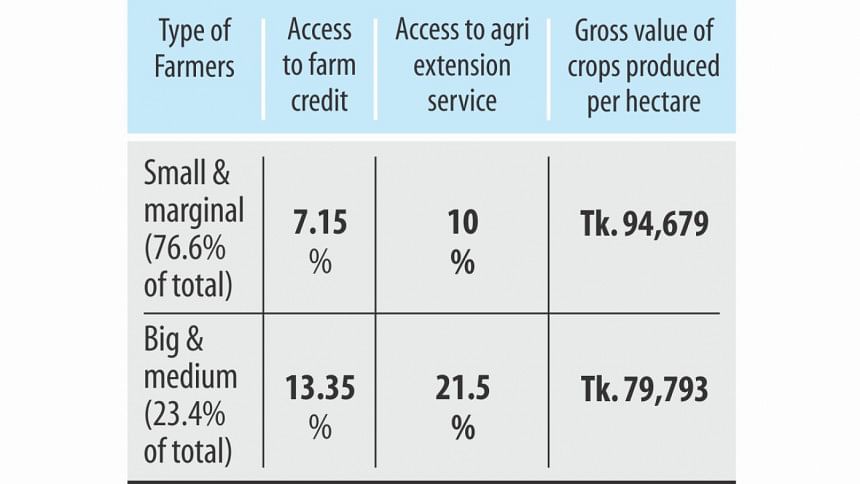Marginal farmers have least access

The country's farm sector is dominated by smallholders but the small and marginal farmers have the least access to the credit and agricultural extension services provided by the state.
A recent nationwide household survey found that the farmers get half the access to state-run Bangladesh Krishi Bank's loans comparing to the large and medium farm owners.
They also get half the attention from the agricultural extension services against the well-off farmers.
In spite of the obstacles, the per unit output from the small and marginal farmers is much higher than the per unit yield from the richer farmers, the survey found.
Over 76 percent of the country's farmers are small and marginal. They either toil in their own small farms (up to 1.49 acres of land) or in others' lands, says the survey.
On the other hand, less than a quarter of the farming community belongs to the category of medium and big farmers who own at least above 1.5 acres of land each.
Over a third of the farmers (36 percent) are pure tenant, who do not own any arable land.
The findings came from the Bangladesh Integrated Household Survey (BIHS) carried out by the International Food Policy Research Institute (IFPRI).
The Washington-based global food policy think-tank surveyed 6,500 households across the seven administrative divisions twice -- first round in 2012 and the second in 2015 -- for the BIHS, which is the most comprehensive and nationally representative household survey ever conducted in Bangladesh.
Akhter Ahmed, lead author of the survey report, said providing the small and marginal farmers with adequate access to institutional credit and effective agricultural extension services is crucial for raising income and enhancing farm output in Bangladesh.
"However, the outreach of these services to smallholder farmers is very low in absolute terms and considerably less than the services provided to richer farmers," he told The Daily Star yesterday on the sidelines of an international workshop on eliminating hunger and malnutrition. The programme, organised by the IFPRI, was held in the city.
Akhter, who heads IFPRI country operation in Bangladesh, emphasised on addressing the complex procedures of public agricultural credit distribution.
While chairing a session in the workshop, former agriculture secretary Anwar Faruque also shed light on cumbersome and graft-ridden credit disbursement procedures in the formal farm loan system.
IFPRI Director General Shenggen Fan told the workshop that after several years of progress the global hunger is on the rise again mainly because of conflicts, droughts and floods in different regions of the world.
He stressed accelerating growth in Bangladesh given the reality that the country still has got 30 percent of its child population vitamin-A deficient and 44 percent of its women anemic.
In his presentation at the workshop, Akhter showed how farm growth, in general, and rice production growth, in particular, has slowed down in recent years.
Growth in farm sector has come down to 2.4 percent in the last five years comparing to 4.7 percent in the previous five years. And rice production growth dipped to just 0.7 percent in the past five years whereas, it was as high as 4.8 percent in the preceding five years.
Akhter as well as other panelists and discussants from the audience emphasised on investing more on farm research and ensuring just prices for the produces so that the farm growth gets accelerated.
Food Minister Qamrul Islam, State Minister for Women and Children Affairs Meher Afroze Chumki, additional secretary of the agriculture ministry Mohammad Nazmul Islam, Executive Director of Krishi Gobeshona Foundation Dr Wais Kabir and USAID Mission Director in Bangladesh Janina Jaruzelski, among others, also spoke in the workshop.
Janina Jaruzelski said high stunting rate has got something to do with the child marriage and early pregnancy in the country. She called for stopping such marriages in Bangladesh.

 For all latest news, follow The Daily Star's Google News channel.
For all latest news, follow The Daily Star's Google News channel. 



Comments